|
– Part 2: Technical specs and special features –
OK, deep breath…
Lady on a Train was sourced from Universal’s 2022 restoration, which was created from a 2K scan of the 35mm composite dupe negative and is framed in its original aspect ratio of 1.37:1. The transfer here boasts a good contrast range with really solid black levels, and while there’s a slight softness to the image in the early scenes, detail is still rather well defined and seems to improve as the film progresses. There is some small movement of the image in frame, but the picture is almost completely clean of dust and damage. Overall, rather nice.
Time Out of Mind was sourced from Universal’s 2022 restoration and created from a 2K scan of the 35mm interpositive in the original aspect ratio of 1.37:1. Detail definition is slightly better here than on Lady on a Train, at least in close-ups and mid-shots, but some of the wider shots are noticeably softer, though not distractingly so. Again, the image displays a pleasing contrast range and solid blacks, and while there are few small dust spots here and there, there is almost no movement of the image in frame.
Singapore was sourced from Universal’s 2021 restoration, created from a 2K scan of the 35mm composite finegrain print, again in the 1.37:1 Academy ratio in which it was originally shown. For the most part, the contrast is attractively punchy here with walloping black levels, but it does occasionally vary, coarsening briefly on the first scene of Mr. and Mrs. Bellows in the room, then returning to normal a short while later – it’s possible that this sequence was restored from a second source. A pleasing transfer otherwise, with the image looking quite crisp and the detail well defined. There are a couple of very visible scratches, but their appearance is brief enough to ignore, and while there are a fair few reianing dust spots and small signs of wear, these are very small and do not distract.
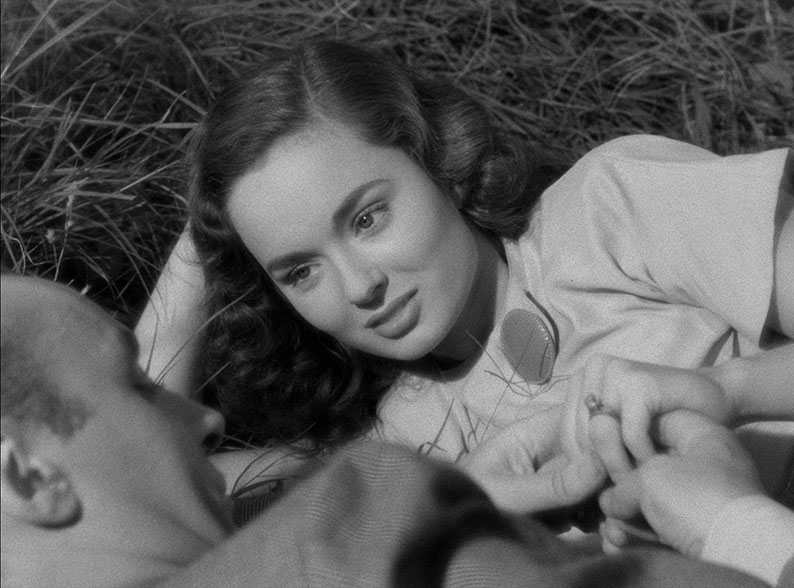
A Woman’s Vengeance was sourced from Universal’s 2021 restoration, which was created from a 4K scan of the original 35mm nitrate negative in the film’s original 1.37:1 aspect ratio. This transfer displays all the strengths of the Singapore restoration and none of its minor weaknesses. The image boasts a very nicely balanced contrast range, and the best material is impressively crisp with very clearly rendered detail – the close-ups of newspaper stories are pristine. There is little in the way of obvious damage or wear, and as with the above titles, a fine film grain is visible.
An Act of Murder was sourced from Universal’s 2013 restoration, created from a 2K scan of the 35mm composite finegrain print in the 1.37:1 aspect ratio. The image here is crisp with very clearly defined detail, and while the image never really pops here, it boasts a nicely spread contrast range that nails the black levels. The film grain is slightly more evident than on the previous titles, but still looks fine. There is, however, one very visible piece of damage to the source print that the restoration has not tackled. It appears in the form of a small collection of tramline scratches that run the full height of the screen on the right-hand side. They first appear at 1:10:17 and vary in quality and intensity, but run continuously for nine-and-half minutes, stopping as suddenly as they begin, which suggests that the damage afflicted two entire reels. Having grown up in an age when films of this vintage were shown on TV in sometimes shocking condition, I found this easy to live with.
The Lady Gambles was sourced from Universal’s 2009 remaster, created from a 35mm finegrain print and presented in the 1.37:1 aspect ratio. The image does display some small signs of wear and scratches, but I only really noticed these when leaning forward to take a close look for this review, and for the most part the picture quality is very good indeed, with a well-balanced greyscale, visible film grain, and very clearly defined picture detail. The best material looks seriously impressive.

All six films have Linear PCM 1.0 mono soundtracks, and all have an inevitably narrow tonal range when compared to modern films (they tend to be treble-leaning, with no real bass and little in the way of mid-range finesse), but the dialogue is always clearly audible and music and sound effects cleanly rendered. The songs on Lady on a Train are particularly well reproduced, so much so that when Deanna Durbin sings Silent Night, the quality jump and the depth of her voice make sound almost as if the song has been sourced from a more recent film. Singapore has probably the weakest soundtrack, with a faint hum audible for much of the film and even some crackle here and there, but it never proves seriously distracting. There is also a faint intermittent hum on An Act of Murder and a few small audible pops at the start, but these soon clear. Otherwise, a fine job all round.
Optional English subtitles for the deaf and hearing impaired have been included for all six features, and pleasingly for all of the short films in the special features too. Bravo.
LADY ON A TRAIN
Audio commentary with Glenn Kenny and Farran Smith Nehme
The first commentary in this set, by the regular pairing of critics and film writers Glenn Kenny and Farran Smith Nehme, gets off to an interesting start when Kenny proclaims that Lady on a Train “may be the weirdest film that Farran and I have done a commentary for,” then adding, “It’s a very odd picture because it’s kind of all over the place in terms of genre and in terms of the persona of its leading lady.” Straight up, I knew that we were going to be on the same page on this one. They have plenty to say about the film as it plays out, noting its oddities and its inconsistencies, opining that while David Bruce isn’t bad in the movie, he does lack star quality, but praising the supporting cast of great character actors and Elwood Bredell’s intermittently noir-like cinematography. They quote from a particularly damning contemporary review by Bosley Crowther, reveal that there is little written material about the film’s production, and pick up on the implied incest undertones. There’s plenty more of interest here.
Theatrical Trailer (2:14)
An unsurprising trailer with a couple of spoilers, and captions announcing that the film features, “Delightful Diana in her first delirious who-done-it” and, a little suggestively, “Deanna Durbin with six mysterious men.”
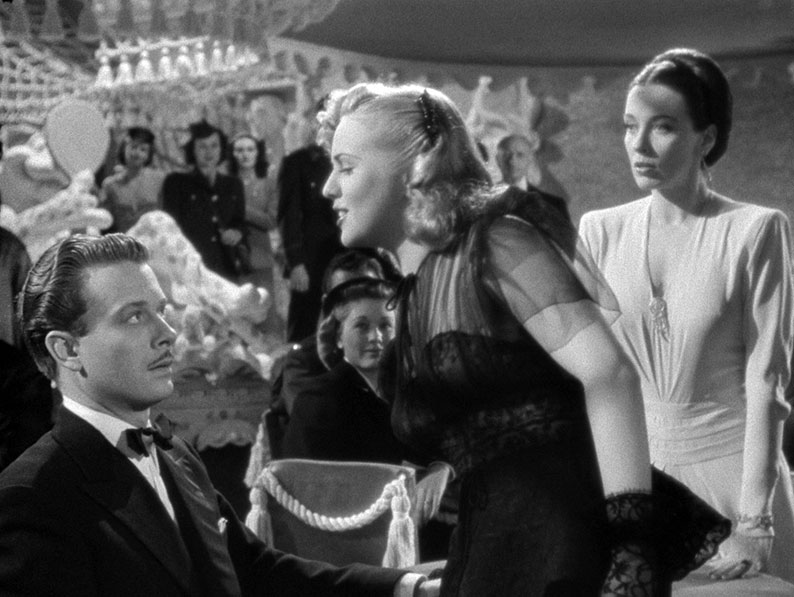
Image Gallery
34 screens featuring some lovely quality monochrome promotional stills, a handful of posed portraits, four behind-the-scenes shots, a single violently coloured lobby card, a newspaper still of the premiere, and a small selection of posters.
Library of Congress (1945) (20:28)
A production of United Films, and number 11 in a series titled The American Scene, this public information film from 1945 tenuously justifies its inclusion here because it is narrated by Ralph Bellamy, who also plays a key role in Lady on a Train. As the title suggests, the film looks at the work of the Library of Congress in Washington (for UK readers, think the American equivalent of The British Library), and while essentially a promotional work, it’s a handsomely made and genuinely educational one. Alexander Hammid directs, and although I’ve not been able to confirm this either way, I suspect that he was also the cinematographer (there are no credits on the film itself), having photographed several short films in his native Austria before moving to the US. And it is beautifully filmed, being littered with sublimely executed dolly shots that help bring a potentially staid subject to life and enhance our appreciation of the huge volume of materials stored at the library. Hammid even goes on location to capture the outdoor recording of what the narrator describes as ‘primitive’ folk songs, a slightly iffy choice of words for performances by blues musicians Sonny Terry and Brownie McGhee and renowned folk singer and activist Woodie Guthrie. Only in a three-minute pause to watch and listen to a live performance of a Beethoven movement by the Budapest String Quartet does the economical pacing of the film falter for a few minutes, but this matters little in a work as well-crafted and fascinating as this. It’s also clear that film has been restored at some point, and despite a fair few remaining dust spots and the occasional signs of former wear, it’s in excellent shape.
TIME OUT OF MIND
Audio commentary with Adrian Martin
Film critic and teacher Adrian Martin comes to this film as a confirmed devotee of the cinema of Robert Siodmak, which informs some really interesting observations he makes about Siodmak’s directorial style here. He does make a couple of claims that I’d argue are not specific to this filmmaker but characteristics of a good many Hollywood directors of the day, but he still makes a strong case for Siodmak’s use of framing, and highlights a crane shot in the finale that is so deftly executed that you almost don’t notice how complex it really is. He notes connections to Alfred Hitchcock’s Rebecca and Orson Welles’ The Magnificent Ambersons and talks about the emotional mapping of spaces and class delineation within the Fortune household, the ways in which the film is faithful and the ways it diverges from Rachel Field’s source novel, the subtextual queer coding, and plenty more. Martin also suggests that the oft-applied 'film noir’ and ‘gothic romance’ labels are inappropriate here, a point on which he and I definitely agree.
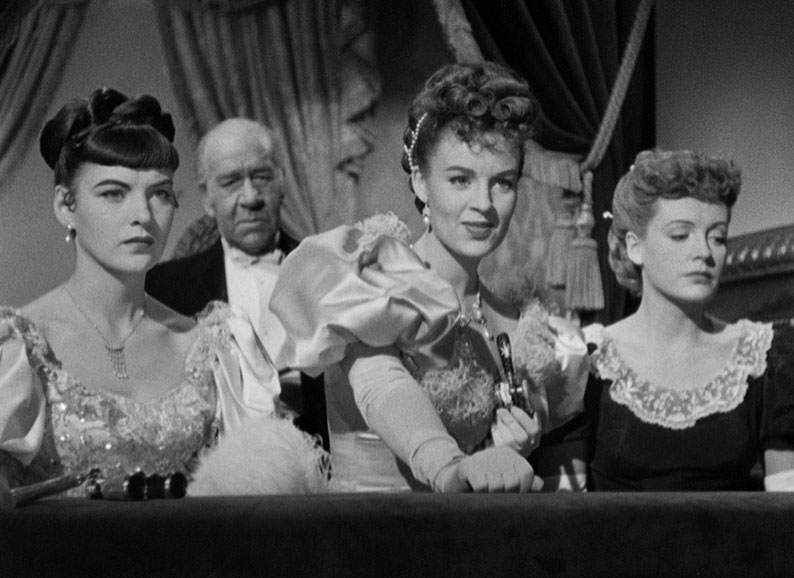
Windows to the Soul: José Arroyo on ‘Time Out of Mind’ (36:07)
Writer and academic José Arroyo provides an overview of director Robert Siodmak’s film career – including his pre- and post-Hollywood work in Germany – then turns his attention to Time Out of Mind, for which he effectively provides a selected scene commentary track. There’s some intriguing analysis here, and while he does echo some of the points made by Adrian Martin in his commentary, he also highlights a couple of interesting elements that I genuinely hadn’t picked up on, particularly regarding the role of windows and doorways in the film. He concedes that there are things in the film that don’t quite work, but in common with Martin, he makes a persuasive case for giving it a second look with specific stylistic and thematic elements in mind.
Bold Venture: ‘The Phyllis Calvert Murders’ (26:52)
First broadcast on 10 September, 1951, this is episode 25 of 57 of Bold Venture, a radio series whose main sales pitch just must have been that it starred Humphrey Bogart as hotel and boat owner Slate Shannon and Lauren Bacall as his young ward, Sailor Duval. Here, they witness a boat crashing into a jetty, and when they rescue its female pilot from the water, they discover that they were too late to save her. As they do so, we learn that her sister Eileen and her boyfriend Richard Marlon were responsible for the woman’s death, but they’re now worried that it might be ruled as suicide, which would invalidate the life insurance policy they were planning to collect. I’ve not heard any other episodes from this series but am presuming that this clunkily developed tale is not a barometer of their overall quality – Bogie and Bacall just about keep it ticking over, despite the over-enthusiasm of the sound effects team. I guess this has been included because the name of the murder victim (coincidentally, I presume) is the same as that of the lead actress in Time Out of Mind.
Image Gallery
32 screen of monochrome promotional stills of varying quality (the best are excellent), an impressively large collection of behind-the-scenes imagery (my favourite has the director presenting Phyllis Calvert with a Christmas present whilst wearing a jacket with “PRONOUNCED SEE’-ODD-MACK” emblazoned across the back), three portrait shots, and a single poster.
SINGAPORE
Audio Commentary with Kelly Goodner and Jim Hemphill
If you’re more interested in information on the actors and filmmakers behind the creation of Singapore than you are in hearing scenes of the film analysed in detail then this commentary by screenwriter and author Kelly Goodner and filmmaker and film historian Jim Hemphill will be right up your street. This is especially true if you want to know more about Ava Gardner, as she gets a lot of coverage here, although there’s also info on Garner’s co-star Fred MacMurray, director John Brahm, cinematographer Maury Gertsman, editor William Hornbeck, and several of the supporting players. There are some details of the shoot and the occasional observation and expressed opinion, but this is primarily a factual commentary, but a lively and thorough one whose most amusing titbit is that one of the exterior night shoots was disrupted for hours by an army of croaking frogs.
A Woman of the World (19:22)
Critic and writer Christina Newland looks at the life and film career of Ava Gardner, focussing specifically on the impact that her performance in Robert Siodmak’s 1946 noir classic The Killers had on her career. She also discusses the actor’s role in Singapore, as well as the notion that there was nothing ‘cartoonish’ about her sexuality, and why her lack of inhibition was deemed shocking at the time.
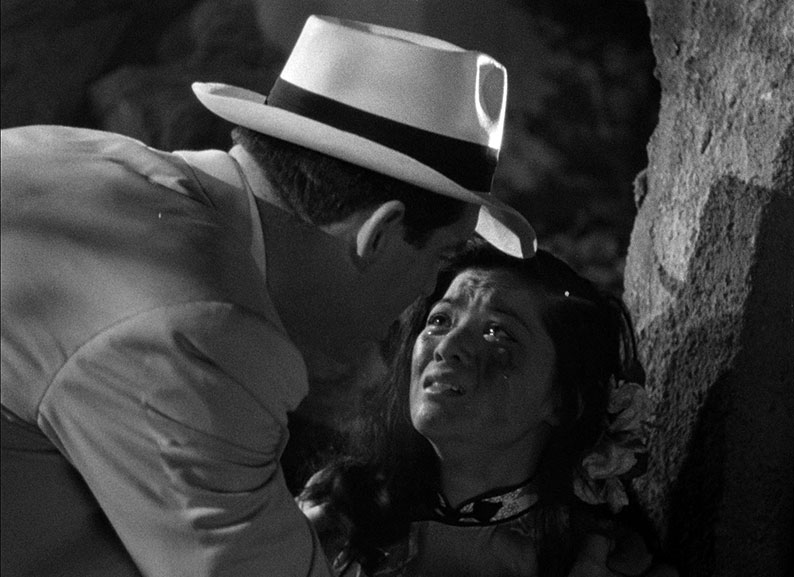
Lux Radio Theatre: ‘Singapore’ (56:20)
A radio adaptation of the film, first broadcast on 3 November 1947, and again starring Fred MacMurray and Ava Gardner in the lead roles. The tacky intermissions to promote other movies and a couple of iffy performances in supporting roles aside, this is a solid adaptation that gets away with spoken exposition by making it memories narrated by the reliable MacMurray. Yes, the story as it plays out in the film is compressed down here, but economically so, and none of the key narrative beats are missed. Good one.
Theatrical Trailer (0:42)
A brief, efficient teaser trailer for “Singapore, city without a conscience,” a tagline you probably won’t see plastered on travel brochures.
Image Gallery
A generous 64 screens featuring plenty of gorgeous, pin-sharp promotional stills, a clip from a typewritten Universal press release, some posed portraits of Fred MacMurray and Ava Gardner (also impeccable quality), one behind-the-scenes photo, a few lobby cards, and a selection of posters.
Reward Unlimited (1944) (10:58)
A wartime recruitment short designed to convince women to join the nursing profession, directed by Jacques Tourneur (whose impressive filmography includes horror masterpieces Cat People and Night of the Demon – but you knew that already) and featuring a small role for actor Spring Byington, who plays Mrs. Bellows in Singapore. Here she plays the mother of lead character Peggy (Dorothy McGuire), who is looking to find a wartime purpose to impress her soldier beau Paul (James Brown), and picks nursing when a small wound she receives after falling in the street is dressed by an experience nurse who just happened to be passing by. Standard stuff for the period, with actors having to deliver lines that would never make their way into real world conversations and that sometimes make them sound like extras in a wartime Truman Show.
With This Ring (1954) (40:13)
A questionably rosy look at the history of the Miller Brewing Company, made to celebrate its 100th anniversary and directed by John Brahm, who frankly did a far more honourable job on Singapore. The decision to have German and French characters speak their own language and not provide translating subtitles is impressive (optional English SDH subtitles are available, but they stick to precisely what is said on screen, whatever the language) and does work for the film, though it misses no opportunity to hammer home that no quality compromises were ever made in the brewing of Miller beer. Try selling that one to Blue Velvet’s Frank Booth. In a shining example of how the rich twist religion to support their capitalistic ambitions, the latest in the Miller line claims in a triumphant final sequence speech, “I see God in the miracle or fermentation.” I’ll remember that one should I ever get arrested for being drunk and disorderly.
A WOMAN’S VENGEANCE
Audio Commentary with Jason A. Ney
Writer and professor of literature and film, Jason Ney, comes to this film as a fan of Aldous Huxley’s original short story, The Giaconda Smile, and I don’t think it counts as a spoiler to reveal that while he does praise elements of the movie adaptation, he is of the opinion that the source material is superior. Ain’t that so often the way? If you’re tuning in for factual information on the lead actors, director Zoltan Korda, cinematographer Russell Metty, composer Miklós Rózsa, and Huxley himself, however, you’re in for a treat. Ney tackles each contributor to the film individually and goes into considerable detail on their lives and careers, including quotes from them and their collaborators about their work and this production in particular. One piece of information revealed here even prompted me to add a footnote to my coverage of one of the other films in this set (read it to see why). He also analyses some dialogue exchanges in the film, pausing to let the sequences unfold and only commenting on them once they have concluded. He unsurprisingly but usefully highlights the differences between the film and the original story, and surprised me by revealing that my favourite scene – one that Ney also believes is the strongest – was not in the short story but created by Huxley specifically for the film.
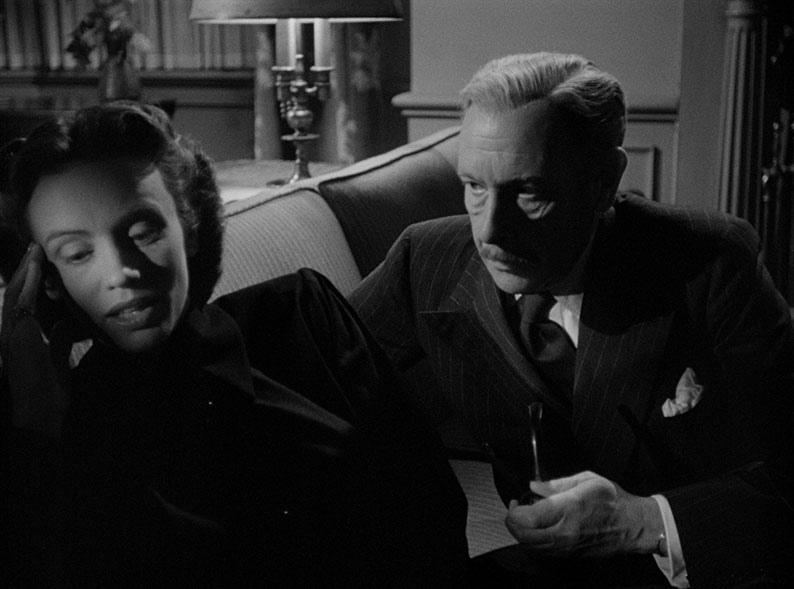
Huxley in Hollywood: Neil Sinyard on ‘A Woman’s Vengeance’ (22:46)
Author and film historian Neil Sinyard looks back at what compelled Aldous Huxley to take up residence in Hollywood, touching on his film projects – including a couple of intriguing-sounding ones that fell by the wayside – before moving on to A Woman’s Vengeance. He praises the performances of Cedric Hardwicke and especially Jessica Tandy, highlights the more noir aspects of the film, and salutes the expressionistic effectiveness of Russell Metty’s lighting in the thunderstorm scene and the sequence in which Caroline shares her suspicions with Janet. He notes how risqué some aspects of the film must have seemed at the time, and the irony in what some regard as a talky screenplay being written by a man who once penned an article opining that silent cinema was far more preferable to films with audible dialogue.
Mollé Mystery Theatre: ‘The Gioconda Smile’ (26:08)
A radio adaptation of the Aldous Huxley story on which A Woman’s Vengeance was based, originally broadcast on 19 June 1945 as part of the Mollé Mystery Theatre series. While many of the story beats are similar to those in the film, the radio play sticks closer to the source material, at least until the end, when it spares one character but adds a second twist to ensure that even infidelity does not go unpunished. There is some wear and damage to the recording, but its archive value outweighs this.
Theatrical Trailer (2:29)
A solid enough little trailer in the usual 40s style that gives about as much away as I do in my review. Well, maybe not quite as much.
Image Gallery
26 screens containing some top quality promotional photos, a couple of behind-the-scene shots, two monochrome German lobby cards, a wider selection of coloured-in English language lobby cards, and a collection of posters, both domestic and European.
French Town… (1945) (12:19)
Made by Realist Film Unit for the Ministry of Information and the U.S. Office of War Information, this well-shot, late WWII short paints a level-headed picture of a recently liberated French town, as the citizens work with American military personnel to rebuild the community. It earns its place in this set due to narration read by A Woman’s Vengeance actor Cedric Hardwicke.
AN ACT OF MURDER
Audio Commentary with Max Evry and Bryan Reesman
Entertainment journalists Max Evry and Bryan Reesman prove a lively and engaging double-act as they examine the film, the moral issues it wrestles with, and the actors and filmmakers who brought it to the screen. They reveal the various titles that were cycled through during the course of the production and the fact that it was still alternating between two of them on its release and describe Doctor Walter’s decision to tell Calvin about Catherine’s condition and advise him to keep it from his wife as “beyond problematic” (a view I share, but see also my footnote on this). Contemporary reviews are quoted from, the courthouse exterior is revealed to be the same backlot set used in To Kill a Mockingbird and Back to the Future, and they pertinently wonder how younger viewers, who may know nothing of the Production Code and the impact it had on the subjects and behaviour that filmmakers were able to explore on screen, might view films that were forced to dance around difficult subjects as a result.

An Act of Marriage: Jill Blake on Fredric March and Florence Eldridge (14:09)
Writer Jill Blake traces the early years of the husband-and-wife acting team of Fredric March and Florence Eldgride and their individual journeys into stage acting, first individually and then later as a couple, and their subsequent transition to Hollywood. She also highlights how they, like so many actors and filmmakers of the day, were targeted by the House Un-American Activities Committee because they had supported humanitarian and equal rights causes. What a world we live in.
Image Gallery
27 screens featuring wonderfully crisp promotional stills, some posed portraits, a single light-hearted behind-the-scenes image, some garishly coloured lobby cards, and a selection of posters.
Welcome Home (1945) (19:55)
A short film, narrated by Fredric March, made to inform those on the home front what the average soldier went through during the Second World War, but also what technical and social skills they may have gained and how prepared they thus were to take up civilian jobs on their return. It’s very well shot and includes documentary footage of genuinely injured soldiers, but also has testimonials from ‘a chaplain’ and ‘a war correspondent’ that are clearly scripted sequences performed by actors. The uncredited filmmakers briefly get to have some fun when visualising what the average GI dreams of experiencing when he gets home. This has clearly been restored and looks really good here.
THE LADY GAMBLES
Audio Commentary with Pamela Hutchinson
Film critic and historian Pamela Hutchinson, whose commentaries are always an enthralling listen, nicely balances the factual with the observational here, providing details on the actors and filmmakers, as well as background information on the film and its production, whilst also analysing individual scenes and offering her opinion on the characters, performances and filmmaking. I learned here that director Michael Gordon disliked what he regarded as a potboiler title and was specifically inspired by Fyodor Dostoyevsky’s short novel, The Gambler**, as well as details of the extraordinary-sounding Las Vegas junket organised to promote the film to the trade press. That Gordon and Barbara Stanwyck were on opposite sides of the political fence is also discussed, with Gordon later blacklisted for refusing to answer questions or name names to the House Un-American Activities Committee, an organisation that the conservative Stanwyck publicly supported. Hutchinson brings up the film’s unfortunate connection to one of America’s first documented mass shootings (as I write this, another has just taken place, this time in Maine – it never ends), confirms that gambling addiction was not taken as seriously as addition to drugs or alcohol at the time, praises Stanwyck’s central performance, and acknowledges the already evident star quality of a soon-to-be-famous young bit part player. Another excellent commentary.
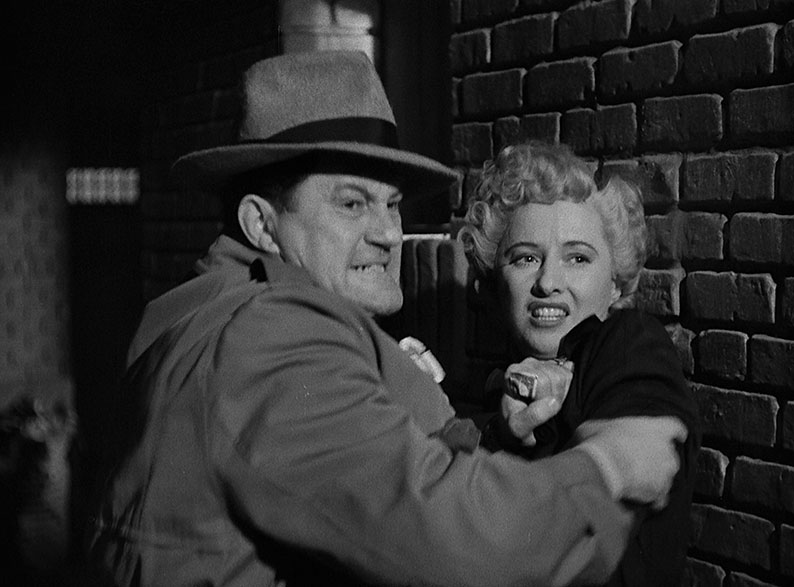
Image Gallery
36 screens of production photos, lobby cards (I think), a typewritten Universal press release clipping, and a good selection of international posters. Interesting that in Italy the film was titled ‘La roulette’.
Sucker Bait (1943) (38:41)
Less a short film than a compressed feature, this splendid piece of noir-influenced wartime propaganda was made to warn the public about the dangers of loose talk – the ‘loose lips sink ships’ doctrine of the day – but does so by accusing those viewing the film of being easy marks for wily German spies. It’s a risky and potentially confrontational move that begins with the narrator (John Nesbitt) introducing us to a class at a German spy school and mockingly noting how you are going to make their work easy, as the adult students acknowledge the camera and laugh at the gullibility of the hapless viewer. Their instructor rubs it in further, calmly announcing that “Today we are discussing a familiar topic – American stupidity.” Later, he is even more direct, assuring his students, “In the United States there is an unlimited supply of careless, slack-jawed imbeciles.” The stories he tells are visualised as small cautionary dramas, and feature three men – two sailors (Stephen McNally of The Lady Gambles and Richard Carlson) and an intelligence office worker (Barry Nelson) – as they make simple mistakes that allow spies to access crucial information about a departing American fleet. In a nicely noir twist, one of the men we’re encouraged to see as a spy (Morris Ankrum) turns out to be an investigating FBI agent. A well-written, really well made work that pulls no punches in achieving its aim. It’s a tragedy that no record appears to have been made of who wrote and directed this gem.
Also included in this set is a 118-page Book (as far as I’m concerned, once you go past 100 pages you can no longer classify such physical extras as a booklet) packed with essays and information on the film, including available credits for all six features and included shorts.
Kicking things off is an essay on Lady on a Train titled The Singing Detective (oh, how I wish I’d thought of that one) by senior lecturer in Cinema and Television History at De Montfort University, Ellen Wright. She makes a valid case for the film being seen as part of an unfairly overlooked cycle of female-investigator noir features in the 1940s, and highlights specific aspects, particularly admiring the sequence in which Durbin serenades her father with a full-length rendition of Silent Night. I’m saying nothing here. Following this is a collection of news stories from New York and Los Angeles publications that includes interview snippets with Durbin and focus on her future plans and her marriage to Lady on a Train director Charles David.
Irish writer, director and producer Paul Duane looks at the early career of Robert Siodmak, before analysing his work on Time Out of Mind, criticising aspects of the film (plot threads go nowhere, he notes, and Christopher “comes off as a whiny, irritating loser most of the time,”) but praising the cinematography and production design. Intriguingly, he quotes lines from the Bob Dylan song Standing in the Doorway and suggests they could apply to this movie. This is partnered with a profile of director Robert Siodmak by Donald Marshman from an August 1947 edition of Life magazine to coincide with the release of Time Out of Mind – which is briefly discussed – and Siodmak is briefly quoted on that and a couple of his other key works.

Freelance reviewer and film historian, Philip Kemp, looks at the career of director John Brahm before focussing specifically on Singapore, aspects of which he compares unfavourably to Casablanca, particularly highlighting what he describes as its “woefully unconvincing” ending, though he does praise other aspects of the production. Following this are extracts from news articles focussing on Ava Gardner and Fred MacMurray, both of whom are briefly interviewed.
Writer and film programmer Tara Judah looks at “the twisted logic at the heart of Aldous Huxley’s screenplay for A Woman’s Vengeance,” and the dated, misogynistic elements of the film, whilst also acknowledging that some of this feel somehow contemporary, points that are well made and convincingly argued. Next up are extracts from several contemporary articles focussing on writer Aldous Huxley, the first of which still has the film taking its title from the short story collection in which The Giaconda Smile first appeared, Mortal Coils.
An Act of Murder is explored by curator and writer Iris Veysey, who discusses the social issue at the film’s core (which I’ve avoided specifying, but you can probably guess the nature of), and the brush lead actor couple Fredric March and Florence Eldridge had with the dreaded House Un-American Activities Committee. This is followed by an article by Ace Bushnell from a December 1948 edition of Tucson Daily Citizen about the film and that central issue, which is identified even in the article’s title.
Writer and film historian, Imogen Sara Smith, looks at The Lady Gambles and its treatment of the issue of gambling addition, also highlighting Barbara Stanwyck’s performance, Roy Huggins’ screenplay, and Russell Metty’s cinematography. After this is a small collection of reports on the lucrative press junket so tantalisingly outlined by Pamela Hutchinson in her commentary track, and how initially uncooperative Las Vegas gambling outlets saw this as a way to promote their new ‘family friendly’ image.
Credits for the short films are joined by short essays on Welcome Home, Library of Congress and With This Ring. As ever, the book is most attractively produced, and illustrated with promotional material for the films.
I’m getting old. I’m sure I could have breezed through this box set a few years ago, but this time it took me a couple of weeks of what free time I have, which has effectively put other reviews on hold, but as so often with Indicator box sets, it proved to be two weeks of often immensely enjoyable cinema and a whole slew of first-class special features. You might question the noir qualifications of a couple of the titles here, but this is still a fascinating and hugely worthwhile collection with some standout movies, six fine commentary tracks, and some really interesting short films, a couple of which I thought were downright excellent. If you have Indicator’s first Universal Noir set or even any of the Columbia Noir collections, you’ve probably already bought this or at least have it on order or on your Christmas wish list, but either way, it comes most highly recommended.
<< Part 1: The Films
|